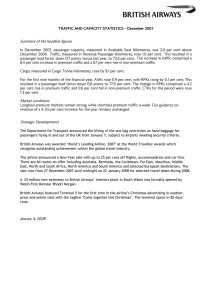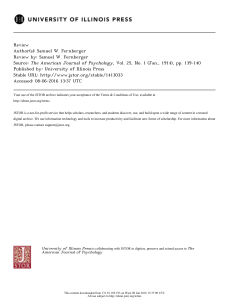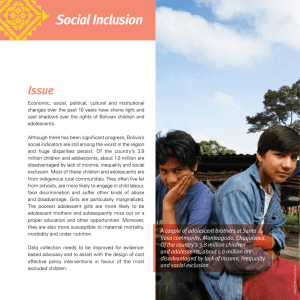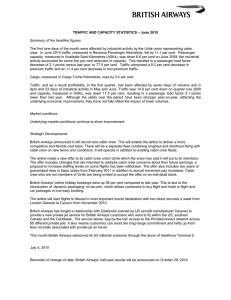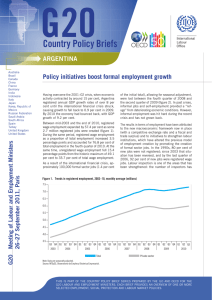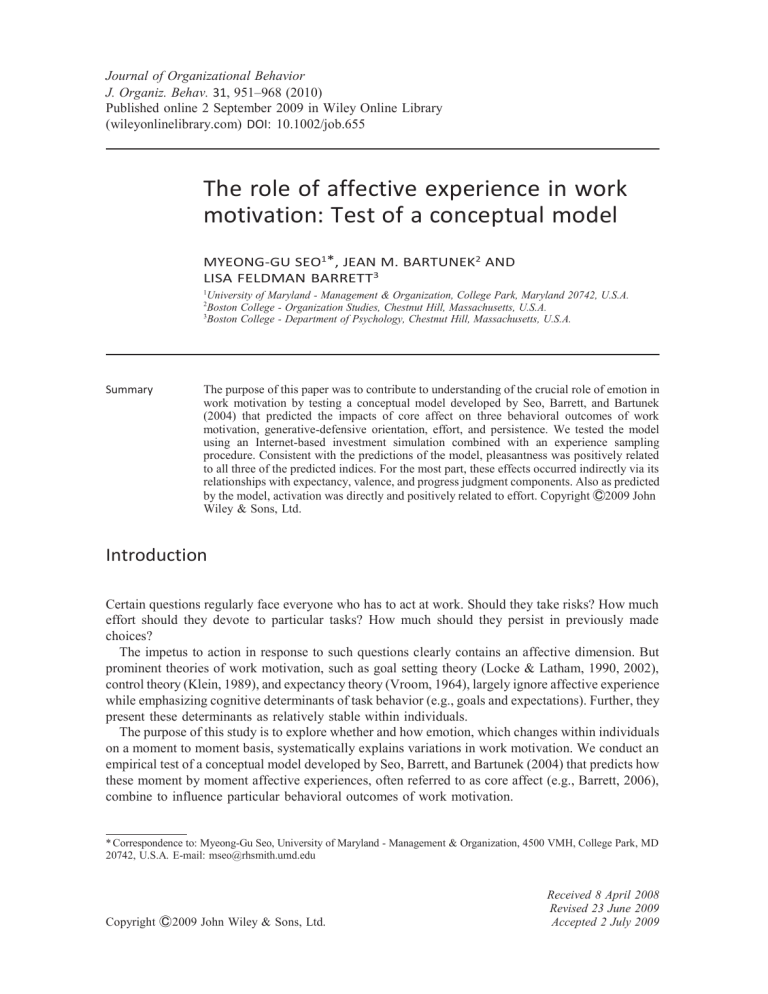
Journal of Organizational Behavior J. Organiz. Behav. 31, 951–968 (2010) Published online 2 September 2009 in Wiley Online Library (wileyonlinelibrary.com) DOI: 10.1002/job.655 The role of affective experience in work motivation: Test of a conceptual model MYEONG-GU SEO1*, JEAN M. BARTUNEK2 AND LISA FELDMAN BARRETT3 1 University of Maryland - Management & Organization, College Park, Maryland 20742, U.S.A. Boston College - Organization Studies, Chestnut Hill, Massachusetts, U.S.A. 3 Boston College - Department of Psychology, Chestnut Hill, Massachusetts, U.S.A. 2 Summary The purpose of this paper was to contribute to understanding of the crucial role of emotion in work motivation by testing a conceptual model developed by Seo, Barrett, and Bartunek (2004) that predicted the impacts of core affect on three behavioral outcomes of work motivation, generative-defensive orientation, effort, and persistence. We tested the model using an Internet-based investment simulation combined with an experience sampling procedure. Consistent with the predictions of the model, pleasantness was positively related to all three of the predicted indices. For the most part, these effects occurred indirectly via its relationships with expectancy, valence, and progress judgment components. Also as predicted by the model, activation was directly and positively related to effort. Copyright Ⓒ2009 John Wiley & Sons, Ltd. Introduction Certain questions regularly face everyone who has to act at work. Should they take risks? How much effort should they devote to particular tasks? How much should they persist in previously made choices? The impetus to action in response to such questions clearly contains an affective dimension. But prominent theories of work motivation, such as goal setting theory (Locke & Latham, 1990, 2002), control theory (Klein, 1989), and expectancy theory (Vroom, 1964), largely ignore affective experience while emphasizing cognitive determinants of task behavior (e.g., goals and expectations). Further, they present these determinants as relatively stable within individuals. The purpose of this study is to explore whether and how emotion, which changes within individuals on a moment to moment basis, systematically explains variations in work motivation. We conduct an empirical test of a conceptual model developed by Seo, Barrett, and Bartunek (2004) that predicts how these moment by moment affective experiences, often referred to as core affect (e.g., Barrett, 2006), combine to influence particular behavioral outcomes of work motivation. * Correspondence to: Myeong-Gu Seo, University of Maryland - Management & Organization, 4500 VMH, College Park, MD 20742, U.S.A. E-mail: mseo@rhsmith.umd.edu Copyright Ⓒ 2009 John Wiley & Sons, Ltd. Received 8 April 2008 Revised 23 June 2009 Accepted 2 July 2009 952 M. SEO ET AL. The Seo et al. (2004) model is the most comprehensive conceptual treatment to date of the roles that various aspects of emotion play in motivated behavior. Other models linking emotion to motivation (e.g., Isen & Baron, 1991; George & Brief, 1996; Erez & Isen, 2002) focus primarily on positive feeling and its effects on effort, leaving out activated feelings as well as other important dimensions of work motivation such as direction and persistence. Only a few papers have empirically examined issues addressed in the Seo et al. (2004) model. Erez and Isen (2002) showed that positive affect increases both expectancy motivation and valence motivation, while Tsai, Chen, and Liu (2007) found that self-reported positive mood at one point in time affects self-reported persistence later. However, the model’s combined propositions have not been comprehensively tested, and conceptual models alone cannot replace empirical tests. Otherwise, potentially erroneous conclusions may be accepted at face value. The Seo et al. Model Briefly, Seo et al. (2004) propose that core affect, as reflected in degrees of pleasantness and activation, influences momentary variation in three behavioral outcomes of work motivation: generative-defensive orientation,1 effort,2 and persistence. It does so both directly and indirectly, by influencing two cognitive judgments addressed by expectancy theory (expectancy judgment and valence judgment) and one addressed by control theory ( progress judgment). We summarize its components below, beginning with the behavioral outcomes of work motivation. Behavioral outcomes of work motivation The first behavioral outcome, generative-defensive orientation, labeled briefly as generative orientation, indicates choices between generativity and defensiveness. A generative orientation is characterized by active engagement to achieve anticipated positive outcomes in spite of possibilities of loss; it is reflected in behaviors such as exploring, innovating, and risk taking (cf. Fredrickson, 2001). In contrast, a defensive orientation is characterized by a protective stance aimed at avoiding potential negative outcomes in spite of possible opportunities to achieve better outcomes (e.g., Staw, Sandelands, & Dutton, 1981). The second behavioral outcome, effort, is the most frequently used index of work motivation (cf. Staw, 1984). It refers to how much time and energy a person devotes to selecting and executing action to complete a given task. The third behavioral outcome, persistence, refers to maintaining (versus changing) an initially chosen course of action over time (cf. Kanfer, 1991). Persistent individuals continue what they have been doing, while less persistent individuals change their current behavior. Many scholars used the term ‘‘direction’’ when they indicate individual choices between mutually exclusive tasks (cf. Locke & Latham, 1990). We use a similar term ‘‘orientation,’’ to describe momentary behavioral choices between mutually exclusive courses of action in performing a given task across time. 2 Seo et al. (2004) used the term intensity. We use the term ‘‘effort,’’ a synonym that is a clearer depiction of the construct. 1 Copyright Ⓒ 2009 John Wiley & Sons, Ltd. J. Organiz. Behav. 31, 951–968 (2010) DOI: 10.1002/job AFFECTIVE EXPERIENCE IN WORK MOTIVATION 953 Core affect A circumplex model of emotion (Russell, 1980, 2003; Russell & Barrett, 1999) argues that affective experience consists of two properties, (1) a degree of pleasantness that summarizes how well one is doing along a valence of pleasant-unpleasant and (2) a degree of activation that summarizes experienced energy in terms of felt activation or deactivation. Seo et al. (2004, p. 424) used the concept of core affect, an expansion of this circumplex model, as the unit of analysis for understanding ‘‘momentary, elementary feelings of pleasure or displeasure and activation or deactivation.’’ Seo et al. (2004) propose that core affect is likely to influence behavioral outcomes of motivation indirectly via affecting three intervening cognitive components, expectancy judgments (the subjective likelihood that certain actions lead to certain expected outcomes), valence judgments (the subjective attractiveness of certain expected outcomes), and progress judgments (the subjective evaluation of progress towards a performance goal). Core affect may also influence these behavioral outcomes directly, unmediated by cognitive processes. Impacts of core affect on generative orientation First (Hypothesis 1a), Seo et al. (2004) hypothesized that more pleasant affective experiences will lead people to have stronger expectations that their actions will accomplish their desired outcomes. This in turn will lead them to engage in more generative task behaviors. Support for this proposition comes from considerable literature that suggests that affective experience influences expectancy judgments (Vroom, 1964). For example, studies of mood congruence recall effects (Mayer, Gayle, Meeham, & Harman, 1990) suggest that people experiencing more pleasant affect tend to focus more on possible positive outcomes of behavioral options and have stronger expectancy judgments of such outcomes (Erez & Isen, 2002; Wegener & Petty, 1996). In contrast, people in less pleasant affective states focus more on possible negative outcomes of behavioral options and have stronger expectancy judgments of negative outcomes (Johnson & Tversky, 1983). Second (Hypothesis 1b), Seo et al. (2004) hypothesized that more pleasant affective experiences lead people to find expected outcomes more attractive, that is, have higher valence judgments of them. This in turn leads to a more generative orientation. According to the feelings-as-information hypothesis (Schwarz, 1990; Schwarz & Clore, 1983, 1988) and the risk-as-feelings hypothesis (Loewenstein, Weber, Hsee, & Welch, 2001), such influence likely occurs when people attribute their feelings to their evaluation of the subjective valence of their choice options. Thus, people experiencing more pleasant feelings will likely consider particular outcomes more attractive than those experiencing less pleasant feelings. Since valence judgments are another determinant of behavioral choice (Vroom, 1964), more pleasant feelings should lead people to exhibit a more generative orientation by increasing the subjective attractiveness of these outcomes. Third (Hypothesis 1c), Seo et al. (2004) hypothesized that pleasant affect directly impacts generative orientation. Pleasant and unpleasant feeling states include inherent action tendencies of moving toward or away from (Frijda, 1987). These propensities are consistent with defensive or generative orientations. Impacts of core affect on effort As noted above in H1a, pleasant feelings should lead people to expect more positive outcomes. Seo et al. (2004) hypothesized (Hypothesis 2a) that this expectancy should lead them to devote more effort Copyright Ⓒ 2009 John Wiley & Sons, Ltd. J. Organiz. Behav. 31, 951–968 (2010) DOI: 10.1002/job 954 M. SEO ET AL. to their current task. According to expectancy theory (Vroom, 1964), people devote more time and energy to tasks from which they expect higher outcomes. Further (Hypothesis 2b), more pleasant affect should lead people to find anticipated outcomes more attractive, which in turn will lead them to devote more effort to their task. This is consistent with the expectancy theory argument (Vroom, 1964) that valence judgments are determinants of effort. Further (Hypothesis 2c), Seo et al. (2004) hypothesized a direct path from the activation dimension of core affect to effort. Activation creates energy that urges individuals to make active efforts to attain or avoid a particular outcome (cf. Brehm, 1999; Cacioppo, Gardner, & Berntson, 1999). Thus, people in more activated feeling states should devote more time and energy to a given task than those in less activated feeling states. Impacts of core affect on persistence Seo et al. (2004) hypothesized (Hypothesis 3a) that pleasant affect will lead people to make more favorable progress judgments. This in turn will lead them to behave more persistently. Research on mood congruence judgment effects (Mayer, Gaschke, Braverman, & Evans, 1992) suggests that people tend to make judgments consistent with their affective state. Thus, people in more pleasant affective states will likely make more favorable progress judgments than people in less pleasant affective states. Further, according to control theory (Carver & Scheier, 1998; Hyland, 1988; Klein, 1989), progress judgments affect persistence. People who believe that they are making good progress towards their goal will likely persist in their current course of action. Seo et al. (2004) also hypothesized that pleasantness will have a direct impact on persistence (Hypothesis 3b). ‘‘Mood maintenance,’’ people’s tendency to behave in a way that maintains their positive affective state (Isen, 2000; Tsai et al., 2007) and ‘‘mood repair,’’ people’s tendency to behave in a way that changes their negative affective state (Forgas, 1995), suggest that more or less pleasant feelings may lead people to maintain or alter a current course of action (Oatley & Johnson-Laird, 1996). For example, Tsai et al. (2007), in one of the few tests of a part of the Seo et al. (2004) model, found that self-reported positive mood at one time period positively affects self-reported persistence at a later time period. Overview of the Study To test the hypotheses, as part of a larger data collection (e.g., Seo & Barrett, 2007; Seo & Ilies, 2009), we examined whether core affect impacted behavioral outcomes of work motivation within individuals across time in an Internet-based stock investment simulation. We chose this domain of behavior because stock investing involves a series of activities having clearly observable variations in all three behavioral outcomes (generative orientation, effort, and persistence).3 3 As recommended by financial theorists (e.g., Bodie, Kane, & Marcus, 2008), all three behavioral outcomes have direct implications for stock investment performance; for example, taking too high or too low in risk (generativeness) or showing too much or too less persistence can negatively affect performance while effort (e.g., information seeking and analysis) may have a positive effect on performance. Copyright Ⓒ 2009 John Wiley & Sons, Ltd. J. Organiz. Behav. 31, 951–968 (2010) DOI: 10.1002/job AFFECTIVE EXPERIENCE IN WORK MOTIVATION 955 We combined the investment simulation with an event-contingent experience sampling procedure (e.g., Barrett, 1998, 2004; Barrett & Barrett, 2001; Beal, Weiss, Barros, & MacDermid, 2005), in which investors rated their feelings and thoughts directly on an Internet web site while simultaneously performing investing activities each day for 20 consecutive business days (cf. Seo & Barrett, 2007). Experience-sampling procedures, in which thoughts and feelings are measured at the time they are experienced, minimize the cognitive biases that can affect memory-based self-reports (Reis & Wheeler, 1991; Wheeler & Reis, 1991). By measuring core affect and all other variables at multiple points of time (17–20 times) for each individual, we could examine within-person effects of core affect on behavioral outcomes as well as summarize its effects across participants. The first author ran the stock investment simulation for 20 consecutive business days (4 weeks). Once a day during the simulation, participants logged into the stock investment simulation website, viewed current market and stock information regarding 12 anonymous stocks that were daily updated from the national stock market, checked their current investment performance, and then decided which and how many shares of stocks to buy or sell that day. Just before making their investment decisions, they reported their current affect as well as their expectancy, valence, and progress judgments about their investment activities. Methods Participants The first author contacted six investment clubs located in the northeast United States, each with 40– 200 members (about 80 members on average), and advertised the investment simulation via public announcement (e.g., face-to-face presentations during regular meetings and/or electronic advertisement via membership email directory). It is not possible to determine with certainty how many members actually received the advertisements and/or the announcements. A total of 118 members from these investment clubs volunteered by the deadline date to participate in the stock investment simulation. At the conclusion of the simulation participants were paid between $100 and $1000 based on their investment performance in it. Participants’ ages ranged from 18 to 74 (Mean¼ 24.7. SD ¼13.2). As is typical in investment clubs, the majority of the participants were male (86 men/ 80 per cent). Their investment experience averaged 4.3 years (SD¼7.4), ranging from 0 to 50 years (no experience: 16 per cent/0–1 year: 20 per cent/2–3 years: 26 per cent/4–5 years: 15 per cent/5–10 years: 16 per cent/more than 10 years: 7 per cent). The measures described below were collected each time participants carried out the simulation. Measurement Core affect We selected eight items (5-point-Likert-scale) that assessed pleasantness and activation. Pleasantness was measured by averaging the scores of four items (happy, satisfied, enthusiastic and relaxed) that are positively valenced and at the same time centered on neutral activation (a ¼ 0.82). Activation was Copyright Ⓒ 2009 John Wiley & Sons, Ltd. J. Organiz. Behav. 31, 951–968 (2010) DOI: 10.1002/job 956 M. SEO ET AL. measured by averaging the scores of four items (aroused, surprised, interested, and nervous) that are high in activation and centered on neutral valence (a ¼ 0.61). Expectancy judgments Expectancy judgments were measured by four items. According to Klein (1991) and Locke, Motowidlo, and Bobko (1986), to measure expectancy judgments in a given task, it is important to (1) provide participants with a range of performance outcomes, (2) ask them to rate their subjective expectancies of each performance outcome, and (3) average their ratings. Similar to the measurement used by Klein (1991), participants indicated on a five-point Likert scale (1: no chance at all (0 per cent), 2: a slight chance (25 per cent), 3: a 50/50 chance (50 per cent), 4: a good chance (75 per cent), 5: completely certain (100 per cent)) the subjective probability of four specific performance outcomes: (1) beat the market by more than 10 per cent, (2) beat the market by more than 5 per cent, (3) beat the market (above 0 per cent), and (4) go below the market return (below 0 per cent/scores were reversed). The items were averaged to produce a single index for expectancy judgments with a higher value indicating higher performance expectancy (a ¼ 0.74 on average across the 20 rounds of the simulation). Valence judgments Also following Klein (1991), valence judgments were measured by four items. To measure valence judgments (perceived attractiveness) participants indicated on a 5-point-Likert scale (1: not important at all, 5: extremely important) the subjective importance of the same four possible performance outcomes as above: to beat the market (1) by more than 10 per cent, (2) by more than 5 per cent, (3) (above 0 per cent), and (4) not to go below the market return (below 0 per cent). The items were averaged to produce a single index for valence judgments with a higher value indicating stronger subjective valence for performance outcomes (average a ¼ 0.77). Progress judgments Progress judgments were measured by a single questionnaire item. Participants selected a number from a seven point Likert scale (— 3: very bad, 3: very good) that best described to this point their subjective judgment regarding how good or bad their prior investment performance had been towards their current performance goals. Generative-defensive orientation Generative-defensive orientation was measured by three indicators in the participants’ investment portfolios that were combined into a single index. First, we measured the degree of diversification, a well-known financial strategy to avoid risk (cf. Bodie, Kane, & Marcus, 2008). To measure diversification, we used Herfindahl’s Index, the sum of the squares of all percentage weights invested in different stocks (0 < Index < 1). A lower score in the Index indicates greater diversification, while a higher score indicates concentration, a generative action to obtain possible positive outcomes. Second, we measured the averaged beta coefficient in a stock portfolio. The beta coefficient of each stock, which participants saw every day during the simulation period, is a measure of the volatility of the stock price in relation to the stock market (cf. Bodie et al., 2008), a well-known parameter of the stock’s potential risk. When the betas are averaged within a given stock portfolio, they indicate the level of risk that the participants choose in constructing their stock portfolio. A lower averaged beta indicates more defensiveness. Third, we measured the averaged 1-year return in a given stock portfolio. The 1-year return of each stock is generally considered as a parameter of a stock’s potential profitability. It points to the level of profitability the participants choose in constructing their stock portfolio. A higher averaged 1-year return indicates a more generative orientation. Copyright Ⓒ 2009 John Wiley & Sons, Ltd. J. Organiz. Behav. 31, 951–968 (2010) DOI: 10.1002/job AFFECTIVE EXPERIENCE IN WORK MOTIVATION 957 A factor analysis (principal component extraction method) showed that these three indicators constituted one factor that explained 61 per cent of the total variance. We used the factor scores (calculated by regression) as an index for a bipolar continuum of generative-defensive orientation, with a higher score indicating a more generative orientation and a lower score indicating a more defensive orientation. Effort We measured the amount of time spent investing by programming the Internet web page in such a way that both the start and the end time of investment decision making were automatically and precisely (in seconds) measured whenever participants moved into and out of the web page designated for their investment decisions. The difference (minutes) between the start time and the end time in the decisionmaking web page was calculated and used to indicate the amount of effort devoted to making investment decisions each day. Persistence Participants’ persistence in maintaining their initially chosen course of action was measured by the reverse ratio ( per cent) of the total stocks traded in absolute value (including both sell and buy) to the total stock portfolio value before the trade. This varied from 0 per cent (least persistent) to 200 per cent (most persistent). Control variables We controlled for two variables, daily stock market movement and daily performance feedback. In measuring daily stock market movement, we used the local market index, the composite index of the 12 stocks that had been randomly selected from the national stock market for use in the simulation. We measured daily performance feedback by computing each participant’s investment return as it was daily updated and reported to the participant. By controlling for these variables we minimized the possible confounding effects of the market and performance related factors on current affect. It was possible that the three behavioral outcome variables were systematically correlated each other. For example, it might take more time (actual effort) to change the current stock portfolio (less persistence) than maintain it (more persistence). Empirically, actual effort was substantially correlated with persistence (r ¼ — 0.37, p < 0.001) and somewhat correlated with generative orientation (r ¼ 0.08, p < 0.01) within individuals. Thus, when one behavioral outcome variable was examined as an endogenous variable, we controlled for the other two. Moreover, as discussed below, we used a fixed-effects (within-subject) methodology in analyzing the data. This allows us to control for any individual-specific (fixed) effects that might be systematically related to the endogenous variables in the hypothesized model (Griliches & Mairesse, 1998), such as the effects of participants’ age, gender, or personality traits, etc. Finally, since progress judgment was measured in relation to the performance goal set daily by participants, we controlled for the performance goal when the hypothesized effects of progress judgment (H3a and H3b) were examined. We measured performance goals by asking participants to indicate their overall target performance outcome for the simulation – a specific investment return compared to the local market return in percentage – by selecting one of the 12 performance goal levels in a pull-down box that listed possible goals in a descending order (the highest level was ‘‘more than 30 per cent above the market return’’ and the lowest level was ‘‘no less than 5 per cent below the market return’’). Copyright Ⓒ 2009 John Wiley & Sons, Ltd. J. Organiz. Behav. 31, 951–968 (2010) DOI: 10.1002/job 958 M. SEO ET AL. Procedure Each day for 20 consecutive business days during the simulation period, participants visited an Internet website once between 6:00 p.m. and 9:00 a.m. the next morning.4 When they accessed the website, they saw a log-in page. To preserve confidentiality, participants were given a code name and password, and reminded that they needed to avoid interruption as much as possible once logging in to the simulation. On the next page they saw the national daily stock market information, including the daily changes and the past-five-day trends of the three major market indices (the Dow Jones, NASDAQ, and S&P500), as well as of the local market index for the simulation, the composite index of the 12 anonymous stocks that had been randomly selected from the national stock market on the basis of varying degrees of risk and profitability and of various industries and company size.5 Next, they saw a web page that contained daily updated information (on the basis of daily closing price) on each of 12 stocks. The information about each stock was limited to its current price (initially set at $100.00 per share but changed in the exact same proportion to the stock’s actual price change thereafter), daily price change ( per cent), average price change rate for the past 5 days, beta coefficient (a stock’s volatility in relation to the market), 1-year stock performance (change in percentage in stock price over the trailing 52 weeks), price-earnings ratio (a ratio of stock price to its trailing 12-month earnings per share), and company size (sales volume). The individual stock names were manipulated (e.g., Stock A, B, and C) in such a way that participants could not identify the real names. On the next page participants saw a report that summarized their most updated investment performance and expected reward so far. All participants began the simulation with a certain amount of monetary reward ($200, real cash). They were shown their current standing with regard to winning (up to $800, real cash) or losing money (up to $100, real cash) each day depending on their investment performance, which was determined by their overall investment return – the percentage amount they earned or lost by investing their initial hypothetical capital ($10 000) compared to the local market return.6 On the next page, participants rated the feelings that comprised their current affective state. Moving to the next page, they reported their subjective judgments of both the likelihood and personal importance of obtaining several specific performance outcomes (expectancy and valence judgments). They also indicated their subjective progress toward their goal ( progress judgment). On the following page, participants indicated their current performance goal. On the next page, participants made their investment decisions for the day – which stocks to sell and which to buy. They could invest all or a part of their hypothetical capital on any of the twelve stocks in the local market as long as the hypothetical cash balance did not go below zero, and were also allowed to trade those stocks freely, with no transaction costs. The web page automatically performed all mathematical calculations required for investment decision making, and instantly checked for mistakes (e.g., overinvestment). The current (national and local) market and stock information that participants had seen in the previous pages also became available for reference in a separate web page. Participants saw their investment summary in a table on the subsequent page and described the reasons behind their investment decisions for that day. Finally, they reported whether, when, and how 4 They were not allowed to log in to the simulation while the national stock market was open (at 9 a.m.) and still moving up and down until 6:00 p.m. in the evening. 5 The local market index had been tracked over several months prior to the simulation and found to be highly correlated with the national market indexes (r > 0.8). During the 20-day period of the simulation, the local market index maintained a relatively good balance of ups and downs (14 ups and 6 downs). 6 Participants were informed at the outset that their investment return was not determined by the simple increase or decrease of their stock portfolio value per se, nor affected by other participants’ performance on the simulation, so that participants would not be motivated simply to capitalize on market fluctuations or to compete with each other. Copyright Ⓒ 2009 John Wiley & Sons, Ltd. J. Organiz. Behav. 31, 951–968 (2010) DOI: 10.1002/job AFFECTIVE EXPERIENCE IN WORK MOTIVATION 959 long they had experienced any interruptions during the tasks for the day. This process was repeated daily for the 20 business days.7 Data structure and data analysis strategy Among the 118 investors who participated in this study, 108 completed the stock investment simulation task. They generated 2059 case-level data (each case included all measures generated by one participant going through one investment session per day). We dropped seven participants due to noncompliance with instructions, and eliminated 63 cases (3 per cent) due to reported interruptions during the sessions (57 cases) or data transfer errors (6 cases). As a result, we used 1870 cases of data completed by 101 participants for data analysis. To analyze this hierarchically structured data set, we used Hierarchical Linear Modeling (HLM; Bryk & Raudenbush, 1992; Raudenbush, Bryk, Cheong, &Congdon, 2000) as the primary statistical procedure. HLM allows analysis of within-subject (lower-level) and between-subject (upper-level) variation simultaneously; each source of variation is modeled while taking the statistical characteristics of the other level into account. In addition, HLM takes account of data dependency in estimating statistical parameters. This is particularly important to our data set, where the case-level data were hierarchically nested within individuals. Specifically, we used HLM for a series of regression analyses to test the hypotheses and other possible impacts of affect on the behavioral outcomes. This path model guided which variables were entered into a series of HLM regressions and in what order; all the variables placed to the left of an endogenous variable in the path model, including the control variables were entered together (controlling for each other) into a HLM analysis to predict the endogenous variable. In addition, as noted above, when one behavioral outcome variable was examined as an endogenous variable, the other two were also entered as control variables. In the HLM regressions we examined the within-person (level 1) relationships among the key variables across all individuals (fixed effects/Gamma).8 Thus, our results are entirely driven by within-individual variation; all the between-individual sources of variance are completely controlled. Results The means and standard deviations of each variable and the correlations among them are shown in Table 1. The key variables in this study vary substantially within individuals across time; withinindividual variance accounted for 39–78 per cent of the total variance. The results of path analyses using HLM regressions are presented in Table 2. We summarize the results in the path diagrams in Figure 1. This figure shows not only the results of our hypothesis testing, but also the additional findings from our analyses. 7 To ensure that all the variables were measured in an order consistent with the hypothesized causal directions, the web pages were programmed in such a way that participants could not skip pages or go back to previous pages to change their original responses. They also could not re-enter the web site in the same day. 8 We estimated the level 1 regression coefficients using within-individual variances by centering the predictor scores relative to each individual’s mean scores. Copyright Ⓒ 2009 John Wiley & Sons, Ltd. J. Organiz. Behav. 31, 951–968 (2010) DOI: 10.1002/job 960 M. SEO ET AL. Copyright Ⓒ 2009 John Wiley & Sons, Ltd. Table 1. Means, standard deviations, variance proportions, and correlationsa Variance proportion Variables 1. Pleasantness 2. Activation 3. Expectancy judgment Mean Within (%) Between (%) 1 2 3 0.58 0.42 0.48 52.9 39.4 44.3 47.1 60.6 55.7 0.28 0.24 0.50 0.29 0.18 0.14 3.00 0.53 0.01 5. Progress judgment —0.41 1.07 6. Generative-orientation 0.70 7. Effort 2.49 1.96 8. Persistence 27.66 30.28 9. Stock market 101.12 1.61 10. Daily performance —0.46 2.13 40.1 59.9 0.15 0.10 0.39 56.0 71.1 57.1 77.5 100.0 54.6 44.0 28.9 42.9 22.5 0.0 45.4 4. Valence judgment 1.13 0.97 2.46 SD 4 0.16 0.19 0.38 0.39 0.19 0.47 0.31 0.02 0.04 0.10 0.06 0.12 0.09 0.18 0.18 0.05 0.02 0.01 0.02 —0.02 —0.01 0.02 —0.02 0.28 0.16 0.48 0.29 5 6 0.40 —0.01 0.18 —0.06 0.52 —0.02 0.25 0.00 —0.02 —0.13 0.09 0.15 0.08 0.08 —0.01 —0.06 0.19 0.73 —0.11 7 0.02 0.07 0.18 8 9 10 b 0.07 N/A 0.26 0.04 N/A 0.21 — N/A 0.55 0.08 0.19 — N/A 0.30 —0.01 —0.07 —0.20 0.06 N/A 0.73 0.14 N/A —0.23 N/A 0.23 —0.37 N/A 0.06 0.03 —0.02 N/A 0.14 0.03 —0.18 N ¼ 1870 (101 participants with 20 rounds). There is no between-person variance in daily stock market movement, because all the participants were daily given exactly the same information on the stock market. Means, standard deviations, and correlations below the diagonal were computed for each individual across rounds and then averaged across individuals (averaged within-individual correlations) whereas correlations above the diagonal were computed across individuals for each round and then averaged across rounds (averaged between-individual correlations). a J. Organiz. Behav. 31, 951–968 (2010) DOI: 10.1002/job b Copyright Ⓒ 2009 John Wiley & Sons, Ltd. Table 2. The results of path analyses using HLM regressions Dependent variables 0.03c (0.08d)ωωω 0.11 (0.54)ωωω Valence judgment Progress judgment 0.01 (0.03) 0.08 (0.33)ωωω 0.02 (0.02) 0.29 (0.63)ωωω 0.03 0.09 (0.10)ωωω 0.04 (0.03) 33.2% 0.03 (0.03) 0.09 (0.07)ωω 12.2% (0.07)ωωω 0.43 (0.23)ωωω 0.05 (0.02) 56.2% Generative orientation 0.07 (0.13)ωωω —0.07 (—0.21)ωωω —0.00 (—0.01) —0.00 (—0.03) — N ¼1870 cases nested within 101 participants. a This variable was controlled when another behavioral outcome variable was examined as an endogenous variable. b This variable, performance goal, was controlled when the hypothesized effects of progress judgment were examined. c Gamma (g) ¼ unstandardized HLM regression coefficient. d Beta (b) ¼standardized regression coefficient ( ¼Gamma (Sx/Sy)). ω p < 0.05; ωωp < 0.01; ωωωp < 0.001. 0.06 (0.04) 0.06 (0.07) —0.02 (—0.01) —0.01 ( 0.20)ωωω Persistence 0.39 (0.02) 0.29 (0.02) —1.54 (—0.04) 3.21 (0.21)ωωω —0.12 ( 0.01) —0.07 (—0.01) 0.40 (0.07)ωω 0.36 (0.08)ωω 0.36 (0.09)ωωω 0.04 (0.02) 12.0% —0.76 (0.01) 0.86 (0.01) 0.74 (0.01) 2.08 (0.03) 3.24 (0.10)ωω 4.6% 961 J. Organiz. Behav. 31, 951–968 (2010) DOI: 10.1002/job 0.02 (0.01) 0.04 (0.02) 0.18 (0.11)ωωω 0.06 (0.04) —0.04 ( 0.05) 9.8% — Effort AFFECTIVE EXPERIENCE IN WORK MOTIVATION Control variables Stock market movement Daily performance Generative orientationa Efforta Persistencea Goalb Predictor variables Pleasantness Activation Expectancy judgment Valence judgment Progress judgment Variance explained % Expectancy judgment 962 M. SEO ET AL. Figure 1. Direct and indirect effects of core affect on task behavior Hypothesis 1: The effects of affective experience on generative orientation. In support of H1a, pleasantness was positively and significantly associated with expectancy judgment (g ¼0.09, b 0.10, ¼ p < 0.001), which, in turn, was positively and significantly related to ¼ p < 0.001). generative orientation (g ¼ 0.18, b 0.11, Contrary to H1b, pleasantness was not significantly related to valence judgment. In addition, the predicted relationship between valence and generative orientation was not significant. We also found no support for the prediction H1c that pleasantness in core affect would influence generative orientation directly. Hypothesis 2: The effects of affective experience on effort. Consistent with H2a, and already noted in conjunction with the discussion of H1a, when participants experienced more pleasant feelings they had a higher expectancy judgment. When they expected more positive outcomes they devoted more effort to their daily stock trading activities (g ¼ 0.36, b ¼ 0.08, p < 0.01). Contrary to H2b, pleasantness was not significantly related to valence judgment, as noted in conjunction with the discussion of H1b. However, valence judgment was significantly and positively ¼ p < 0.001). related to effort (g ¼ 0.36, b 0.09, Consistent with H2c, activated feelings were positively and directly related to effort (g ¼ 0.40, b ¼0.07, p < 0.01). When participants felt more activated, they spent more time in stock investing regardless of their expectancy and valence judgments. Copyright Ⓒ 2009 John Wiley & Sons, Ltd. J. Organiz. Behav. 31, 951–968 (2010) DOI: 10.1002/job AFFECTIVE EXPERIENCE IN WORK MOTIVATION 963 In addition, we found an unpredicted effect: activated feelings positively and indirectly contributed to effort. They were positively related to valence judgment (g¼0.09, b ¼ 0.07, p < 0.01), and, as noted above, valence judgment was positively related to effort. Hypothesis 3: The effects of affective experience on persistence. Consistent with H3a, pleasant feeling was significantly and positively associated with progress judgments (g ¼0.43, b ¼0.23, p < 0.001). Progress judgments were significantly and positively ¼ p < 0.01). Contrary to H3b, however, pleasantness was not related to persistence (g ¼3.24, b 0.10, significantly and directly related to persistence. Discussion Summary of findings and implications for the Seo et al. model As shown in Figure 1, the results of this study support many of the components of the Seo et al. (2004) model, and make evident that core affect, indirectly or directly, is significantly related to all of three behavioral outcomes of motivation, generative orientation, effort, and persistence. In terms of generative/defensive orientation, consistent with H1a, pleasantness was positively related to expectancy judgments which, in turn, were positively related to generative orientation. Contrary to H1b and H1c, pleasantness was directly associated neither with generative-defensive orientation nor with valence judgments. In terms of effort, consistent with H2a, pleasantness was positively related to expectancy judgment, which in turn was linked with effort. Consistent with H2c, activation was directly and positively associated with effort. Contrary to H2b, pleasantness was not significantly related to valence judgments, although valence judgments were positively linked to effort. In terms of persistence, supporting H3a, pleasantness was positively related to progress judgment, which in turn, was associated with persistence. Contrary to H3b, pleasantness was not directly related to persistence. Thus, half of the Seo et al. model was supported (four out of eight hypotheses), suggesting its overall value. At the same time, the results of this study point to a role of activation in work motivation that was not fully identified by the Seo et al. model. Their model predicted that activation would directly influence the behavioral outcome of effort. But our results showed that activation also influenced effort indirectly via its relationship with valence. Past research and theorizing regarding the role of activation has been seriously limited (Cropanzano, Weiss, Hale, & Reb, 2003). Clearly, more research and theorizing is needed to explore its roles in motivational processes more fully. Two hypotheses that were not supported had to do with predictions of valence judgment (H1b and H2b). Indeed, pleasantness was significantly and positively related to valence judgment (g ¼ 0.06, b ¼0.06, p < 0.05), consistent with H1b and H2b, but the relationship became non-significant when activation was entered and controlled. This finding suggests that in constructing valence judgments, individuals may draw more information from their sense of arousal than from the pleasantness of their current feelings (cf. Damasio, 1994). Similarly, valence judgment was significantly and positively ¼ related to generative orientation (g¼0.09, b 0.06, p < 0.05), consistent with H1b, when expectancy judgment was not entered and controlled. These findings suggest that the lack of support in the predictions of valence judgment was largely due to the conservative approach to an empirical test in this study (e.g., statistical over-control), rather than the nonsupport of the theory. Copyright Ⓒ 2009 John Wiley & Sons, Ltd. J. Organiz. Behav. 31, 951–968 (2010) DOI: 10.1002/job 964 M. SEO ET AL. The two other unsupported hypotheses (H1c and H2b) were related with the direct effects of pleasantness on generative orientation and persistence. These effects remained non-significant even after the three cognitive variables (expectancy, valence, and progress judgments) were removed from the HLM equations. These results suggest that pleasant affect, contrary to activation that has a direct impact on effort, does not influence behavioral outcomes in a direct fashion, but only indirectly, via first coloring individuals’ cognitive judgments. It is important to understand more fully the various indirect means through which pleasantness has impacts on work motivation. Overall, the results of the study are important with regard to the foundational premise of the Seo et al. (2004) model, in that they demonstrate clearly that core affect plays significant roles in task motivation. Both pleasantness and activation dimensions of core affect are related to the three behavioral outcomes of task motivation. Further, their impacts come about primarily, although not exclusively, by means of their relationships with multiple cognitive judgments. Notably, these relationships were found strictly within individuals after controlling for all between-individual sources of variances. This makes evident that core affect, which changes within individuals over time at a moment to moment basis, is an important motivational property that systematically predicts behavioral choice, intensity, and persistence that also vary substantially within individuals over time. Implications for expectancy theory and control theory There has been some disagreement about what, if any, advances have been made in expectancy theory in the past decade (Latham & Pinder, 2005). Control theory has been also criticized for its overly simplistic and mechanistic orientation (e.g., Locke & Latham, 1990; Bandura & Locke, 2003). The results of this study lend some support to expectancy theory and control theory by demonstrating that expectancy, valence, and progress judgments impact the behavioral outcomes of motivation. But the results also suggest that it is crucial to understand how affect evokes the judgments associated with expectancy theory and control theory. Expectancy, valence and progress judgments are bound up with how pleasant and activated the person is feeling. Further, some of these cognitive judgments may be bypassed entirely if one has very activated feelings (e.g., Brehm, 1999; Damasio, 1994; LeDoux, 1996). Thus, our results suggest that it is necessary to understand expectancy theory and control theory within a larger affective framework. Practical Implications Contrary to the popular belief that emotions are counter-productive to work performance, the results of this study suggest that they have positive implications for work motivation and thus for work performance in several ways. First, pleasant feelings foster a generative action orientation, such as creativity (George & Zhou, 2002) or risk-taking (Isen, 2000); they increase effort devoted to a given task, and promote persistence in current courses of action. Activated feelings also lead people to devote additional effort to a given task regardless of their current judgments about it. As a result, these feeling states may positively contribute to work performance in situations where a generative orientation, effort, or persistence are critical elements determining motivational outcomes. Thus, managers who desire that these behavioral outcomes be demonstrated at work might develop work environments that constantly foster their employees’ pleasant and activated feelings, for example, by designing and assigning tasks to those employees that are inherently inspiring, stimulating, and interesting. Copyright Ⓒ 2009 John Wiley & Sons, Ltd. J. Organiz. Behav. 31, 951–968 (2010) DOI: 10.1002/job AFFECTIVE EXPERIENCE IN WORK MOTIVATION 965 Our findings also provide managers with some simple but useful ways of predicting and responding to employees’ affective states. When managers perceive that their subordinates are feeling less pleasant or unpleasant, they can predict that the employees may behave more defensively (less generatively), devote less effort, or act less persistently than usual. If such a behavioral prediction is not consistent with the goal of the work unit, managers may make efforts to interrupt the current unpleasant feelings and induce more pleasant feelings, such as by providing a break or humor. Similarly, managers can predict that their employees will be less effortful when they feel low arousal or deactivated (e.g., feeling tired or sleepy), and thus respond to such feelings by taking actions to boost a sense of energy or arousal, for example, by playing stimulating music. Limitations and future research directions In addition to research to explore relationships between pleasantness and behavioral outcomes of motivation (indicated above), additional research is needed to extend the generalizability of the findings of this study and to address its limitations. First, the study is based on a correlational research design, and thus it is not possible to determine the precise causal relationships among the key variables. To precisely determine them, this study should be supplemented by studies in which pleasant and activated feelings are experimentally induced. In this regard, the findings of the two experimental studies of Erez and Isen (2002) supplement our results and add to more generalizable understandings that a broad range of affective feelings influence work motivation via their effects on cognitive processes. Second, people’s motivation in many work settings is continuously influenced by complex group (e.g., leadership and team dynamics) and organizational (e.g., organizational cultures or climates) factors, while this simulation incorporated a purely individual-based task. Moreover, the characteristics of the task involved in this study, simulated stock investment, are different from many other task characteristics. For example, the task in this study is more cognitive-dependent, analysis-based, and time-bounded (20 business days) than other tasks. In particular, the strong cognitive orientation in this task may partly explain our findings that the effects of pleasantness on motivation occurred only via its effects on cognitive judgments in this study. In addition, the task environments employed in this study directly reflected those typical in the financial industry, which are highly dynamic and uncertain in nature and thus require active and appropriate management of risks to improve performance. Such industry-specific task environments cannot be assumed in different types of tasks in different industries. Further research should test the Seo et al. (2004) conceptual framework in team or work-group settings within work organizations and/or in different types of tasks within different industrial contexts, to examine its general applicability. Third, expectancy theory suggests that an additional judgment component, instrumentality (a belief that certain performance will lead to secondary outcomes, such as rewards) may influence work motivation. We controlled instrumentality by design. However, Erez and Isen (2002) provided empirical evidence that instrumentality plays an important role in linking affect–performance relationships. Thus, a valuable future research direction is to explore the role of instrumentality in linking broader properties of affective experiences (beyond positive affect) and key dimensions of task behaviors. Finally, our study used self-reports, especially of feelings. These were about current feelings, and thus avoided a memory bias. Nevertheless, people may not always recognize accurately how they are feeling; as Barrett (2004, p. 266) noted, ‘‘There is no known objective, external measure of the subjective, internal events that we experience as anger, sadness, fear, and so on.’’ However, in three studies Barrett (2004) disentangled the extent to which self-reports of feelings were indicative of Copyright Ⓒ 2009 John Wiley & Sons, Ltd. J. Organiz. Behav. 31, 951–968 (2010) DOI: 10.1002/job 966 M. SEO ET AL. feelings as opposed to cognitive structures, and found some support for the idea that descriptions of feelings are driven by the properties of the feelings. More research on the assessment of feelings in ways that do not require intrusive physiological procedures would obviously be of value to studies such as ours. Conclusion Through testing the Seo et al. (2004) model, supporting it to a considerable extent, and suggesting an extension of it with regard to the role of activation, we have provided an empirical understanding of how momentary affective feelings are related to behavioral outcomes of motivation. Our work and the theory it supports confirm the value of enhanced attention to the crucial role that feelings play in motivation. Author biographies Myeong-Gu Seo is an assistant professor in the R. H. Smith School of Business at the University of Maryland. He received his Ph.D. in organization studies from Boston College. His research focuses on emotion in organization, organizational change and development, and institutional change. Jean M. Bartunek is the Robert A. and Evelyn J. Ferris chair and Professor of Organization Studies at Boston College. She is a fellow and past president of the Academy of Management. Her doctorate in social and organizational psychology is from the University of Illinois at Chicago. Her primary substantive research interests center around organizational change and the cognition and affect that accompany it. Her primary methodological interests are in academic-practitioner relationships, especially in terms of collaborative research. Lisa Feldman Barrett is currently Professor of Psychology and Director of the Interdisciplinary Affective Science Laboratory at Boston College, as well as Assistant in Research at Harvard Medical School at Massachusetts General Hospital. Her major research focus addresses the nature of emotion from social-psychological, psychophysiological, cognitive science, and neuroscience perspectives. References Bandura, A., & Locke, E. A. (2003). Negative self-efficacy and goal effects revisited. Journal of Applied Psychology, 88, 87–99. Barrett, L. (1997). The relationship among of momentary emotional experiences, personality descriptions, and retrospective ratings of emotion. Personality and Social Psychology Bulletin, 23, 1100–1110. Barrett, L. F. (1998). Discrete emotions or dimensions? The role of valence focus and arousal focus. Cognition and Emotion, 12, 579–599. Barrett, L. F. (2004). Feelings or words? Understanding the content in self-report ratings of experienced emotion. Journal of Personality and Social Psychology, 87, 266–281. Copyright Ⓒ 2009 John Wiley & Sons, Ltd. J. Organiz. Behav. 31, 951–968 (2010) DOI: 10.1002/job AFFECTIVE EXPERIENCE IN WORK MOTIVATION 967 Barrett, L. F. (2006). Valence is a basic building block of emotional life. Journal of Research in Personality 40, 35– 55. Barrett, L. F., & Barrett, D. J. (2001). An introduction to computerized experience sampling in psychology. Social Science Computer Review, 19, 175–185. Beal, D. J., Weiss, H. M., Barros, E., & MacDermid, S. M. (2005). An episodic process model of affective influences on performance. Journal of Applied Psychology, 90, 1054–1068. Bodie, Z., Kane, A., & Marcus, A. J. (2008). Essentials of investments (7th ed.) New York: McGraw-Hill. Brehm, J. W. (1999). The intensity of emotion. Personality and Social Psychology Review, 3, 2–22. Bryk, A. S., & Raudenbush, S. W. (1992). Hierarchical linear models: Applications and data analysis methods. Newbury Park: Sage. Cacioppo, J. T., Gardner, W. L., & Berntson, G. G. (1999). The affect system has parallel and integrative processing components: Form follows function. Journal of Personality and Social Psychology, 76, 839–855. Carver, C. S., & Scheier, M. F. (1998). On the self-regulation of behavior. New York: Cambridge University Press. Cropanzano, R., Weiss, H. M., Hale, J. M. S., & Reb. J. (2003). The structure of affect: Reconsidering the relationship between negative and positive affectivity. Journal of Management, 29, 831–857. Damasio, A. R. (1994). Descartes’ error: Emotion, reason, and the human brain. New York: Avon Books, Inc. Erez, A., & Isen, A. M. (2002). The influence of positive affect on the components of expectancy motivation. Journal of Applied Psychology, 87, 1055–1067. Forgas, J. P. (1995). Mood and judgment: The affective infusion model (AIM). Psychological Bulletin, 117, 39–66. Fredrickson, B. L. (2001). The role of positive emotions in positive psychology: The broaden-and-build theory of positive emotions. American Psychologist, 56, 218–226. Frijda, N. H. (1987). Emotion, cognitive structure, and action tendency. Cognition and Emotion, 1, 115–143. George, J. M., & Brief, A. P. (1996). Motivational agendas in the workplace: The effects of feelings on focus of attention and work motivation. In B. M. Staw, & L. L. Cummings (Eds.), Research in organizational behavior (pp. 75–109). Greenwich, CT: JAI Press. George, J. M., & Zhou, J. (2002). Understanding when bad moods foster creativity and good ones don’t: The role of context and clarity of feelings. Journal of Applied Psychology, 87, 687–697. Griliches, Z., & Mairesse, J. (1998). Production functions: The search for identification in practicing econometrics. Z. Griliches (Ed.), Essays in method and application (pp. 232–411). Northampton, MA: Elgar. Hyland, M.E., (1988). Motivational control theory: An integrative framework. Journal of Personality and Social Psychology, 55, 642–651. Isen, A. M. (2000). Positive affect and decision making. In M. Lewis, & J. M. Haviland-Jones (Eds.), Handbook of emotions (2nd ed., pp. 417–435). New York: The Guilford Press. Isen, A. M., & Baron, R. A. (1991). Positive affect as a factor in organizational behavior. In B. M. Staw, & L. L. Cummings (Eds.), Research in organizational behavior (pp. 1–53). Greenwich, CT: JAI Press. Johnson, E., & Tversky, A. (1983). Affect, generalization, and the perception of risk. Journal of Personality and Social Psychology, 45, 20–31. Kanfer, R. (1991). Motivation theory and industrial and organizational psychology. In M. D. Dunnette & L. M. Hough (Eds.), Handbook of industrial and organizational psychology (Vol. 1, pp. 76–170). Palo Alto, CA: Consulting Psychologists Press. Klein, H. J. (1989). An integrated control theory model of work motivation. Academy of Management Review, 14, 150–172. Klein, H. J. (1991). Further evidence on the relationship between goal setting and expectancy theories. Organizational Behavior and Human Decision Processes, 49, 230–257. Latham, G. P., & Pinder, C. C. (2005). Work motivation theory and research at the dawn of the twenty-first century. Annual Review of Psychology, 56, 485–516. LeDoux, J. E. (1996). The emotional brain: The mysterious underpinnings of emotional life. New York: Simon & Schuster. Locke, E. A., & Latham, G. P. (1990). A theory of goal setting and task performance. Englewood Cliffs, NJ: Prentice-Hall. Locke, E. A., & Latham, G. P. (2002). Building a practically useful theory of goal setting and task motivation: A 35-year odyssey. American Psychologist, 57, 705–717. Locke, E. A., Motowidlo, S. J., & Bobko, P. (1986). Self-efficacy theory in contemporary psychology. Journal of Social & Clinical Psychology, 4, 328–338. Loewenstein, G. F., Weber, E. U., Hsee, C. K., & Welch, N. (2001). Risk as feelings. Psychological Bulletin, 127, 267–286. Copyright Ⓒ 2009 John Wiley & Sons, Ltd. J. Organiz. Behav. 31, 951–968 (2010) DOI: 10.1002/job 968 M. SEO ET AL. Mayer, J. D., Gaschke, Y. N., Braverman, D. L., & Evans, T. W. (1992). Mood-congruent judgment is a general effect. Journal of Personality and Social Psychology, 63, 119–132. Mayer, J. D., Gayle, M., Meeham, M. E., & Harman, A. K. (1990). Toward a better specification of the moodcongruency effect in recall. Journal of Experimental Psychology, 26, 465–480. Oatley, K., & Johnson-Laird, P. N. (1996). The communicative theory of emotions: Empirical tests, mental models, and implications for social interaction. In L. L. Martin, & A. Tesser (Eds.), Striving and feeling: Interactions among goals, affect, and self-regulation (pp. 363–393). Mahwah, NJ: Lawrence Erlbaum Associates. Raudenbush, S., Bryk, A., Cheong, Y. F., & Congdon, R. (2000). HLM 5: Hierarchical linear and nonlinear modeling. Lincolnwood, IL: SSI. Reis, H. T., & Wheeler, L. (1991). Studying social interaction with the Rochester Interaction Record. Advances in Experimental Social Psychology, 24, 269–318. Russell, J. A. (1980). A circumplex model of affect. Journal of Personality and Social Psychology, 39, 1161–1178. Russell, J. A. (2003). Core affect and the psychological construction of emotion. Psychological Review, 110, 145– 172. Russell, J. A., & Barrett, L. F. (1999). Core affect, prototypical emotional episodes, and other things called emotion: Dissecting the elephant. Journal of Personality and Social Psychology, 76, 805–819. Schwarz, N. (1990). Feelings as information: Informational and motivational functions of affective states. In E. T. Higgins, & R. M. Sorrentino (Eds.), Handbook of motivation and cognition: Foundations of social behavior (Vol. 2, pp. 527–561). New York: Guilford. Schwarz, N., & Clore, G. L. (1983). Mood, misattribution and judgments of well-being: Informative and directive functions of affective states. Journal of Personality and Social Psychology, 45, 513–523. Schwarz, N., & Clore, G. L. (1988). How do I feel about it? The informative functions of affective states. In K. Fiedler, & J. P. Forgas (Eds.), Affect, cognition, and social behavior (pp. 44–62). Toronto: Hogrefe International. Seo, M., Barrett, L., & Bartunek, J. M. (2004). The role of affective experience in work motivation. Academy of Management Review, 29, 423–439. Seo, M., & Barrett, L. F. (2007). Being emotional during decision making, good or bad? An empirical investigation. Academy of Management Journal, 50, 923–940. Seo, M., & Ilies, R. (2009). The role of self-efficacy, goal, and affect in dynamic motivational self-regulation. Organizational Behavior and Human Decision Processes, 109, 120–133. Staw, B. M. (1984). Organizational behavior: A review and reformulation of the field’s outcome variables. Annual Review of Psychology, 35, 627–666. Staw, B. M., Sandelands, L. E., & Dutton, J. E. (1981). Threat-rigidity effects in organizational behavior: A multilevel analysis. Administrative Science Quarterly, 26, 501–524. Tsai, W., Chen, C., & Liu, H. (2007). Test of a model linking employee positive moods and task performance. Journal of Applied Psychology, 92, 1570–1583. Vroom, V. H. (1964). Work and motivation. New York: Wiley. Wegener, D. T., & Petty, R. E. (1996). Effects of mood on persuasion processes: Enhancing, reducing, and biasing scrutiny of attitude-relevant information. In L. L. Martin, & A. Tesser (Eds.), Striving and feeling: Interactions among goals, affect, and self-regulation (pp. 329–362). Mahwah, NJ: Lawrence Erlbaum Associates. Wheeler, L., & Reis, H. (1991). Self-recording of everyday life events: Origins, types, and uses. Journal of Personality, 59, 339–354. Copyright Ⓒ 2009 John Wiley & Sons, Ltd. J. Organiz. Behav. 31, 951–968 (2010) DOI: 10.1002/job

